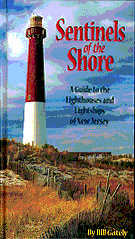Q. & A. About New Jersey’s Lighthouses
from Sentinels of the Shore
Q. How many lighthouses and lightships have existed in New Jersey throughout the state’s history?
A. New Jersey has been home to forty-nine lightstations, which stretched along New York Harbor, down the Atlantic coastline, and up Delaware Bay to the Delaware River. Twenty-six of these stations still exist today.
Q. What is the northernmost lightstation in the state?
A. The Statue of Liberty. Though usually viewed as a New York landmark, the statue actually stands in New Jersey waters and served as navigational aid from 1886 until 1901.
Q. Why is a New Jersey lighthouse nicknamed “Katie’s Light”?
A. Robbin’s Reef Lighthouse, located off Bayonne about two miles southwest of the Statue of Liberty, was nicknamed after one of the lighthouse’s earliest keepers, Kate Walker, took over the duties of her husband, Jacob, after he died in 1890. A mother who would row her two children to school on Staten Island every morning, Kate tended the light for 33 years and is credited with saving at least 50 lives.
Q. Which lighthouse holds the record as the oldest operating lighthouse in the United States?
A. Sandy Hook Lighthouse, built in 1764 at the northern tip of the Sandy Hook peninsula. Except for when it was darkened during the war with Spain in 1898 and again during World War II, the light has served continuously for 232 years.
Q. Which was the first major seacoast light to use electricity?
A. Twin Lights — two brownstone towers built in 1862 on the Navesink Highlands — became the first major seacoast light to use electricity when a generator was installed there in 1898. At the turn of the century, Twin Lights was considered the best and most powerful light in America, with a visibility of more than 20 miles.
Q. Which lighthouse became the first in America to have a Fresnel lens?
A. Twin Lights, in 1841. Developed in 1822 by Augustin Fresnel (pronounced “fray-Nel”), this type of lens replaced kerosene lamps and quickly became the highest standard in lighting. Two sets of prisms concentrated light through a central magnifying lens, intensifying the light’s brightness. Graded by “orders” from first (the best) to sixth, a Fresnel lens could weigh up to ten tons but be so perfectly balanced it could easily be rotated by hand.
Q. Which Civil War hero helped to build three New Jersey lighthouses?
A. George Meade — who would gain fame as the Union general who won the Battle of Gettysburg — was a government engineer prior to the Civil War. During the 1850s he designed Barnegat, Absecon, and Cape May lighthouses, all of which he outfitted with first-order Fresnel lenses — the best illumination available.
Q. What are “range” lights?
A. “Ranges” consisted of at least two lighthouses: a front light (or “beacon”) close to shore, and a rear light (or “range”) usually a mile or more behind it. In New Jersey, these ranges were used to mark shipping channels in Sandy Hook Bay and up the winding Delaware River; a mariner could position a ship by maneuvering until the rear range light shone directly over the beacon. Occasionally ranges consisted of three lighthouses; the Horseshoe Range East Group along the Delaware had a common rear light for two beacons that marked the channel in both directions.
Q. Which New Jersey lightstations were among the first to use radio beacons?
A. In 1921 Ambrose Lightship, which marked the entrance to Ambrose Channel, and Sea Girt Lighthouse became two of only three lightstations to have a radio beacon installed. (Fire Island Lighthouse in New York was the third.) During World War II the Coast Guard used Sea Girt Lighthouse as a headquarters for patrolling the beach against invasion and as a lookout for U-Boats.
Q. Which was the last New Jersey lightstation to be run by keepers?
A. Ambrose Tower, which marked Ambrose Channel. Established in 1967 to replace a lightship of the same name, the tower did not become automated until 1988; until then, keepers were transported to and from the structure by helicopter.
|
|
|
